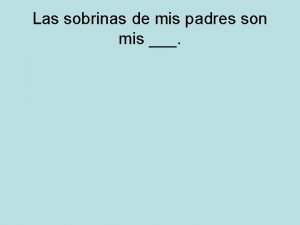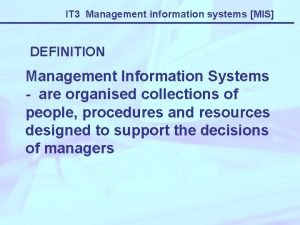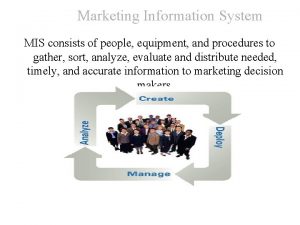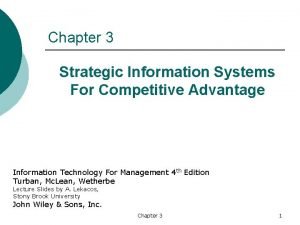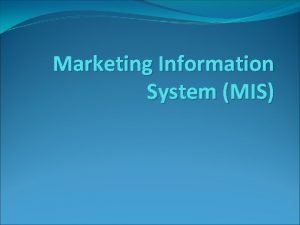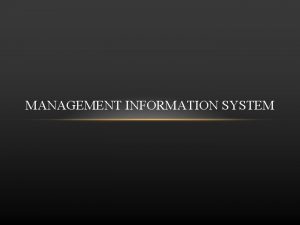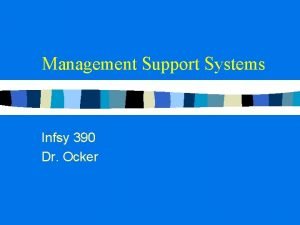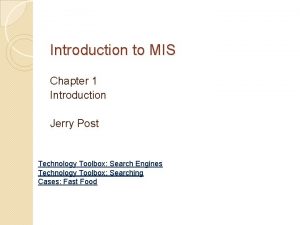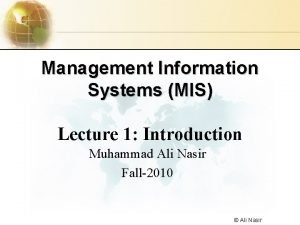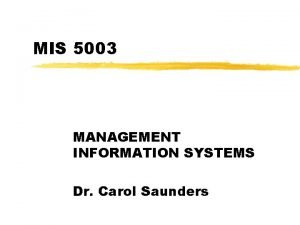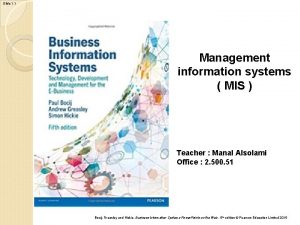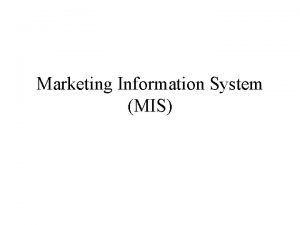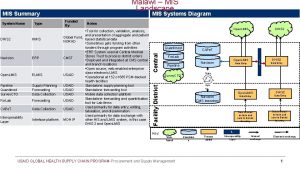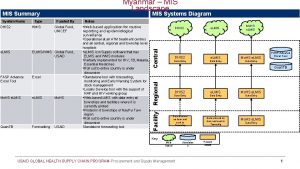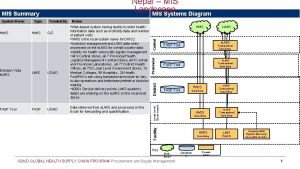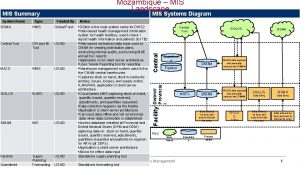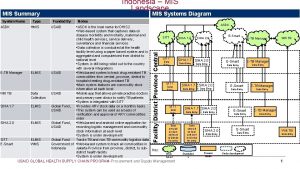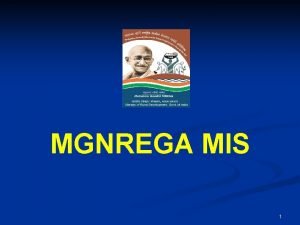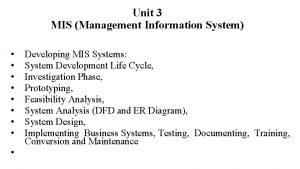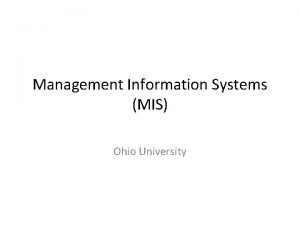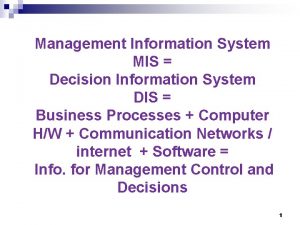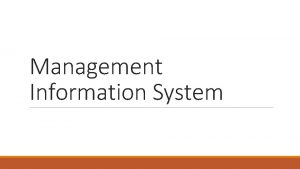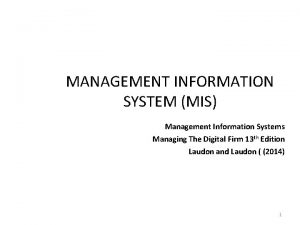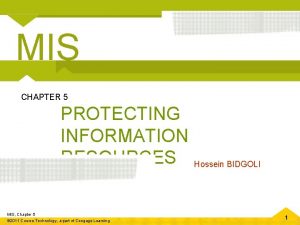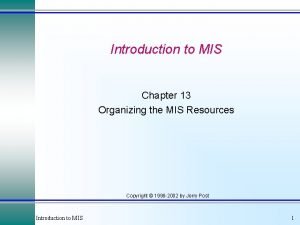MANAGEMENT INFORMATION SYSTEM INTRODUCTION Management Information System MIS

















- Slides: 17

MANAGEMENT INFORMATION SYSTEM

INTRODUCTION Management Information System (MIS) provides information for the managerial activities in an organization. The main purpose of this research is, MIS provides accurate and timely information necessary to facilitate the decision-making process and enable the organizations planning, control, and operational functions to be carried out effectively. Management Information System (MIS) is basically concerned with processing data into information and is then communicated to the various Departments in an organization for appropriate decision-making.

SCOPE OF STUDY The term "MIS" arose to describe such applications providing managers with information about sales, inventories, and other data that would help in managing the enterprise. Today, the term is used broadly in a number of contexts and includes decision support systems, resource and people management. .


WHAT IS MIS? 1) Right Information 2) To the right person 3) At the right place 4) At the right time 5) In the right form 6) At the right cost

Characteristics of a Management Information System 1) Provides reports with fixed and standard formats - Hard-copy and soft-copy reports 1) Uses internal data stored in the computer system 1) End users can develop custom reports 1) Requires formal requests from users

THE MIS DEFINITION 1) The MIS is defined as an integrated system of man and machine for providing the information to support the operations, the management and the decision making function in the organization. 1) The MIS is defined as a system based on the database of the organization evolved for the purpose of providing information to the people in the organization.

INFORMATION CHART

VARIOUS TYPES OF MIS transaction processing systems : Management information systems (MIS), per se, produce fixed, regularly scheduled reports based on data extracted and summarized from the firm’s underlying transaction processing systems to middle and operational level managers to identify and inform structured and semi-structured decision problems. Decision support systems (DSS) are computer program applications used by middle management to compile information from a wide range of sources to support problem solving and decision making.

Executive information systems (EIS) is a reporting tool that provides quick access to summarized reports coming from all company levels and departments such as accounting, human resources and operations. Marketing information systems are MIS designed specifically for managing the marketing aspects of the business.

Office automation systems (OAS) support communication and productivity in the enterprise by automating work flow and eliminating bottlenecks. OAS may be implemented at any and all levels of management. School management information systems (MIS) cover school administration, and often including teaching and learning materials.

ADVANTAGE • The following are some of the benefits that can be attained for different types of management information systems.

Companies are able to highlight their strengths and weaknesses due to the presence of revenue reports, employees' performance record etc. The identification of these aspects can help the company improve their business processes and operations. Giving an overall picture of the company and acting as a communication and planning tool.

The availability of the customer data and feedback can help the company to align their business processes according to the needs of the customers. The effective management of customer data can help the company to perform direct marketing and promotion activities. Information is considered to be an important asset for any company in the modern competitive world. The consumer buying trends and behaviours can be predicted by the analysis of sales and revenue reports from each operating region of the company.


NEED OF MIS Information that needs to be recorded and studied includes relevant information of the department for planning process as well as specific information to know whether one involved in SWM services is performing his duty well, adequate vehicles are given to the SWM Dept. by the workshop, the vehicles give their optimum output, the repairing and maintenance of vehicles and equipment at the workshop is properly done, the vehicles carrying the waste to the disposal site are optimally utilised, the processing plants are performing well, landfill sites are well managed etc. The first thing each morning the chief executive should see is whether anything unusual or unsatisfactory has happened needing immediate remedial measures. A list of items is given below on which the data should be collected and kept on record for planning purposes and a few proformae are designed for monitoring the activities done by various sections of SWM department as under which may be utilised by the local bodies with suitable modifications.

 Mi mision proyecto de vida
Mi mision proyecto de vida La hija de mis padres es mi
La hija de mis padres es mi Mis mai a mis tachwedd
Mis mai a mis tachwedd Mis mai a mis tachwedd
Mis mai a mis tachwedd Cuales son mis creencias
Cuales son mis creencias What is management information system with example
What is management information system with example Management information systems definition
Management information systems definition What is marketing mis
What is marketing mis Strategic information system advantages
Strategic information system advantages Mis meaning
Mis meaning Introduction of management information system
Introduction of management information system Introduction of management information system
Introduction of management information system Management information systems chapter 1
Management information systems chapter 1 Management support systems
Management support systems Introduction of mis
Introduction of mis Introduction of mis
Introduction of mis Data vs information in mis
Data vs information in mis Quality of information in mis
Quality of information in mis

